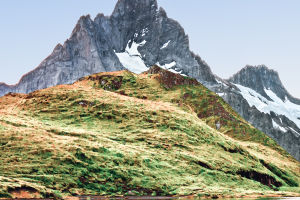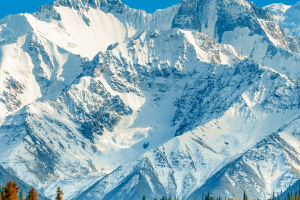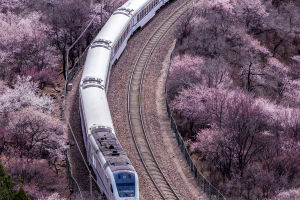On June 25, 1930, the first train named "Glacier Express" ran from Zermatt to St. Moritz, covering a 300-kilometer journey in about 7.5 hours, and was therefore called "the world's slowest scenic train."
The glacier in the name refers to the Rhone Glacier, which is adjacent to the village of Grech. Once the largest glacier in Europe, it has shrunk to become the fifth largest glacier in Switzerland due to climate warming.
On the way from Zermatt to St. Moritz, the glacier train traverses the Alps, crossing 291 bridges and 91 roads, and goes over the Oberap Pass, the highest point of which is 2,033 meters above sea level. The entire route is on narrow gauge railroad tracks with some use of toothed rails on steep gradients.
The body of the Glacier Express is red, the soft seats are red, and even the curtains are red. The seats on the Glacier Express are wide and comfortable. On the Swiss Glacier Express, there is a state-of-the-art radio guide service, but it is only played through headphones to keep the car quiet.
Whenever the next "point of interest" is about to appear, the screen on the carriage door will show the headset label, and the number behind the label corresponds to the number of the landscape on the map, making it clear and convenient.
Because the Swiss Glacier Express is known as the world's slowest express train, you can imagine how reserved it is while moving. The reserved pace of the Swiss Glacier Express makes it easy to capture all the scenery within the frame.
The Alps' perennial glaciers and snowy peaks are rolling, and the endless white covers the vast and luxurious forests, the original continental customs of the homes, and large pastures, but the knife-like mountains still struggle to faintly reveal their rough lines, and the high hanging bridges and the dangerous defiles of the thrilling soaring look more shocking at this time.
Sitting on the Swiss Glacier Express, shuttling through one glacier after another, through the snow-capped towns of Switzerland, the beauty in front of you is always not enough to see.
It is not the tourist's greed for glacier beauty but such a rare and unique experience that you don't want to pass up easily. When the Swiss Glacier Express comes to a stop, tourists are always reluctant to get off the train.
However, the Glacier Express has now turned into a train running on the remains of the glaciers, and the Swiss glaciers are dying at an unprecedented speed in the heavy mountains through which the train travels.
Along the way, you can only see the glacier melt accompanied by the glacier along the railway track, and the source of the glacier is the second-largest glacier in Switzerland - Gerner Glacier.
Not far from Zermatt, Saas-Fee is a famous glacier village in Switzerland, surrounded by glaciers, and the livelihood of the villagers is closely related to the glacier resources.
There are 21 cable cars in the village of Saas-Fee, but with the rapid melting of the glacier, which may cause the mountain to shift or the cable car infrastructure to loosen, the cable car company has a lot of work to do.
In addition, Saas-Fee has unique trams built underneath the glacier, and melting glaciers are threatening the trams. Some of the glacier meltwater has already seeped into the rocks and into the underground tunnels, which could become a bigger problem in the long run.
In the village of Saas-Fee, they are proud of their ice palace, where visitors can ski even in the summer. However, the ice palace, located at an altitude of 3,500 meters, has partially melted this summer, and some scenic spots have had to be closed to tourists.
The glacier train cannot see the glacier, drawing attention to global climate change. This is not solely a matter of sightseeing.


